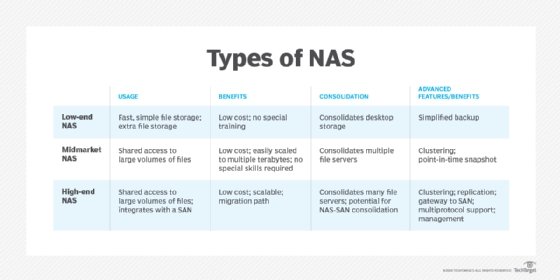How to set up a NAS: A step-by-step configuration guide
Get the most out of your rackmount NAS appliance by setting up admin accounts, permissions and network access; running a diagnostic check; and configuring advanced options.
Storage hardware has a reputation for being somewhat difficult to configure, but NAS appliances can be surprisingly easy to set up.
This tip focuses on how to set up rackmount NAS appliances, but there are other form factors, such as towers, mini towers, desktops and so on. Rackmount NAS appliances generally offer more sophisticated capabilities and higher capacity than competing form factors.
NAS setup 101: Understanding NAS device components
A NAS device is essentially just a computer that has been optimized for use as a shared storage device. Like any other computer, a NAS appliance contains one or more CPUs and memory. The CPU speed and the amount of memory within the device have a major effect on its overall performance. Enterprise-grade NAS appliances, for example, are often equipped with Intel Xeon processors, whereas consumer-grade NAS systems might include an Intel Atom processor or something similar.
Enterprise-grade NAS appliances typically use error-correcting memory and have larger quantities of memory than lower-end systems. An enterprise NAS can easily contain 128 GB of RAM or more, while a consumer-grade NAS might only contain 8 GB.
Like any other computer, a NAS appliance also contains an OS. NAS OSes are usually proprietary, although there are appliances that run Linux or Windows. The OS' job is to manage the appliance's hardware and run the management interface.
Modern NAS devices typically include a web interface for storage management and to configure and monitor the appliance. Therefore, the appliance's OS is configured to act as a web server. However, some vendors include keyboard, video and mouse ports directly on the NAS appliance, making it possible to configure and manage it without the need for a web application or a dedicated client app.
Some NAS manufacturers also provide an app store, making it possible to run backup or security apps directly on the appliance. Often, this app store contains well-known enterprise applications and utilities, as opposed to only offering proprietary apps from the NAS vendor.
An appliance can include several drive bays that collectively accommodate multiple disks. These bays are connected internally to a RAID controller. NAS appliances might have internal ports for M.2-style NVMe SSDs. In addition, it's relatively common for a NAS appliance to include USB ports that external storage drives can use.
A NAS server also includes ports for network connectivity. The port offerings vary considerably based on vendor and model, but Gigabit Ethernet ports are common, as are 10 GbE ports.
In an enterprise environment, a gigabit connection is commonly attached to the management network, while higher-speed ports accommodate user traffic on the local network or replication traffic associated with another NAS device. Enterprise-grade NAS appliances often offer multiple 10 GbE ports. It's sometimes possible to achieve throughput speeds of 25 GbE to 50 GbE through expansion boards.
10 steps for NAS device configuration
Each vendor has its own setup method, but there are 10 basic steps involved in how to set up a rackmount NAS appliance.
1. Prepare the hardware
This includes mounting the appliance in the rack, installing the hard disks, and attaching the power and network cables.
2. Configure administrative accounts
It is a huge security risk to leave the default username and password enabled. At the very least, you must change the default password. The best practice is to create a separate account for each member of the administrative staff. Some appliances include built-in support for Active Directory authentication.
To configure the administrative accounts, you must log in to the appliance. Each vendor has its own way of providing access to the administrative interface. Some vendors provide access through a web browser, while others provide customers with a dedicated client application.
3. Perform a diagnostic check
At a minimum, this means verifying that the appliance has correctly detected all its hard disks. Many vendors include a built-in diagnostic function that users can run to assess the overall health of the appliance.
4. Configure the storage architecture
In most cases, this means configuring the disks to be part of a RAID array. However, organizations commonly configure NAS appliances as JBOD storage. It isn't always appropriate to include every hard disk in a RAID configuration. Sometimes, hard disks are used for caching or as a hot spare, as noted in step nine.
5. Create volumes
The number of volumes depends on how the organization will use the appliance. If the appliance will be used as a file server, for example, it might be appropriate to create a single, large volume. If the firm uses the NAS appliance for departmental file sharing, the departments could be isolated from one another by creating a separate volume for each department.
6. Configure access permissions for the volumes
This can mean a few different things, depending on the appliance's purpose. If the appliance will be used as a file server, you must establish share-level permissions. Depending on the file system the appliance uses, you might also need to establish some file-level permissions.
7. Configure network access
You must assign an IP address to the appliance -- unless you plan to use dynamically assigned IP addresses -- and create the corresponding DNS host record. Typically, you also must enable the appropriate access protocol. Most higher-end NAS appliances support multiple access protocols, such as SMB, NFS, FTP or iSCSI, and it's up to administrators to enable the protocols they want to use.
8. Configure notifications
The rackmount appliance should now be accessible, but there are a few more tasks to set up the NAS, such as configuring notifications. NAS appliances usually have a built-in alerting mechanism that can let the administrator know if the appliance is having a problem. Such a mechanism might, for example, provide notifications of events such as fan failures, low disk space or disk failures.
Enabling the notification option usually involves configuring the appliance to communicate with your mail server and then providing the email address or distribution list address to which you want the notifications sent. As an alternative, you may be able to configure your appliance to send notifications to a centralized monitoring and alerting tool.
9. Configure advanced options
The advanced options tend to vary significantly from one vendor to the next, but they could include automatic RAID rebuilding, write caching, designating a network interface or a hard disk as a hot spare, or enabling the appliance to shut down in response to a power failure.
10. Configure the backup
Although not technically a NAS configuration step, the last thing you should do is create a backup job to protect the NAS appliance. Usually, you can't install backup agents onto a NAS appliance, so backups are commonly based on Network Data Management Protocol. NDMP was designed to transport data between backup servers and NAS appliances.
Setup and usage considerations for different NAS device types
Although it's easy to assume that an enterprise-class organization would purchase large, high-end NAS devices, such an organization may also use smaller ones. As such, consider the best use based on NAS type.
Low-end NAS devices
A low-end business NAS -- not a consumer NAS -- is typically for tasks such as file sharing, media storage and backup within teams consisting of less than 50 people. These NAS devices can sometimes allow for more than 100 TB of data storage, depending on the disks that are installed. However, low-end NAS devices typically cannot be daisy-chained to other NAS devices as a way of achieving additional scalability.
Low-end NAS devices are most often for individual teams or in remote locations, such as branch offices or other network edge spots. These locations might require storage but have limited IT resources and hardware budgets.
Some organizations configure low-end NAS appliances to act as a storage cache within branch offices. This setup is especially true of situations in which employees at a branch office may have to traverse a WAN link to access an organization's file server. Caching or replicating frequently used files to a NAS device can improve performance for users in the branch office.
Midmarket NAS devices
Midmarket NAS devices tend to be for large departments or within branch offices containing between 50 and 250 users. While these NAS appliances can be for file storage or backup, just like a low-end NAS appliance, they are also sometimes used for virtualization. Some NAS vendors integrate a hypervisor into midmarket NAS appliances, enabling those appliances to host VMs without the need for a separate server. In other cases, a traditional virtualization host may be linked to a midmarket NAS appliance by way of an iSCSI or Fibre Channel connection.
Regardless of their use, midmarket NAS devices tend to be near the users that they service, as opposed to in the organization's data center. This setup helps to ensure that the NAS users experience the best possible storage performance.
High-end NAS devices
High-end NAS devices almost always reside within the enterprise data center and can easily service more than 250 users. While organizations can certainly use these devices for hosting enterprise file services, they can serve several other purposes. High-end NAS devices are best suited for any mission-critical workload that demands high availability, scalability, large-scale data storage or a high level of performance.
High-end NAS appliances generally scale better than midmarket NAS. You can usually connect your high-end NAS appliances to one another to accommodate mutipetabyte workloads. They usually support replication between devices, which helps to ensure high availability for mission-critical workloads.

Additional best practices for NAS software and backup management
Organizations that make use of NAS servers must keep those servers up to date. NAS vendors periodically release firmware updates that improve security and correct known problems. Some hard disk manufacturers even release firmware updates for individual disks. In any case, it's important to keep your appliances up to date. The same can also be said for any external clients used to manage NAS appliances.
Another best practice is to avoid backing up a NAS volume to another volume on the same NAS. Although such backups do technically store backups in a location that is separate from the original data, this approach does nothing to protect the data against a NAS-level failure. Additionally, the backup process can adversely affect a data volume's performance due to the load that is placed on the device's CPU and memory.
Brien Posey is a former 22-time Microsoft MVP and a commercial astronaut candidate. In his more than 30 years in IT, he has served as a lead network engineer for the U.S. Department of Defense and a network administrator for some of the largest insurance companies in America.






